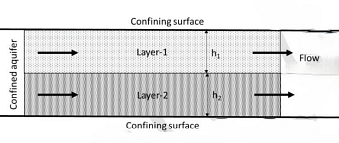Consider two horizontal layers of an aquifer as shown in figure. Each layer is isotropic and homogeneous. Flow is parallel to the stratification. Thickness and horizontal hydraulic conductivity of layer-1 are $h_1$i and $K_1$, respectively. Thickness and horizontal hydraulic conductivity of layer-2 are $h_2$ and $K_2$, respectively, where $h_1$ is not equal to $h_2$. The equivalent horizontal conductivity $K_x$ for the aquifer system is given by _____


\(k_x = \frac{k_1.h_1 + k_2.h_2}{h_1 + h_2}\)
\(k_x = \frac{k_1+K_2}2\)
\(k_x = \frac{k_1.h_3 + k_2.h_2}{h_1 + h_2}\)
\(k_x = \sqrt{k_1.k_2}\)
The Correct Option is A
Solution and Explanation
Step 1: Equivalent horizontal hydraulic conductivity. When flow is parallel to the stratification, the equivalent horizontal hydraulic conductivity \( K_x \) for the aquifer system is given by: \[ K_x = \frac{\sum (K_i \cdot h_i)}{\sum h_i} \] where \( K_i \) and \( h_i \) are the hydraulic conductivity and thickness of the \( i \)-th layer, respectively.
Step 2: Substitute for two layers. For two layers, the equation becomes: \[ K_x = \frac{K_1 h_1 + K_2 h_2}{h_1 + h_2} \]
Step 3: Interpretation of the terms. \( K_1 h_1 \): Contribution of layer-1 to the equivalent hydraulic conductivity. \( K_2 h_2 \): Contribution of layer-2 to the equivalent hydraulic conductivity. \( h_1 + h_2 \): Total thickness of the aquifer system.
Step 4: Verify the given options. The correct formula for equivalent horizontal conductivity matches: \[ K_x = \frac{K_1 h_1 + K_2 h_2}{h_1 + h_2} \]
Top Questions on Fluid flow
- Based on the rheological behavior of fluid, all of the following shows time independent property, except:
- Potential function for three dimensional doublet of strength \( \mu \) is
- The physical principle used for the derivation of momentum equation is
- Which of the following states that the time rate of change of circulation around a closed curve consisting of the same fluid elements is zero?
- Based on the rheological behavior of fluid, all of the following shows time independent property, except:
Questions Asked in GATE ES exam
In the given figure, the numbers associated with the rectangle, triangle, and ellipse are 1, 2, and 3, respectively. Which one among the given options is the most appropriate combination of \( P \), \( Q \), and \( R \)?

A regular dodecagon (12-sided regular polygon) is inscribed in a circle of radius \( r \) cm as shown in the figure. The side of the dodecagon is \( d \) cm. All the triangles (numbered 1 to 12 in the figure) are used to form squares of side \( r \) cm, and each numbered triangle is used only once to form a square. The number of squares that can be formed and the number of triangles required to form each square, respectively, are:

The number of patients per shift (X) consulting Dr. Gita in her past 100 shifts is shown in the figure. If the amount she earns is ₹1000(X - 0.2), what is the average amount (in ₹) she has earned per shift in the past 100 shifts?

- Water from a hand pump located near a landfill has 1 mg/L arsenic (oral carcinogenic potency factor = 1.75 (kg-day)/mg). A person who lives nearby drinks 2 L/day of water from this hand pump for 10 years. Assume a body weight of 70 kg and an average life duration of 70 years. The chances of this person getting an excess risk of cancer is ________ × 10-3 (rounded off to three decimal places).
- GATE ES - 2025
- Hydrology
- An industry releases three greenhouse gases (GHGs), CO2 (5 kg/day), CH4 (0.5 kg/day), and N2O (0.1 kg/day). The industry flares the CH4 before it is released to the atmosphere. The Global Warming Potential (GWP) are as follows: CO2 = 1, CH4 = 21, N2O = 310. The annual GWP of GHGs released from the industry is ________ kg CO2 equivalent (rounded off to the nearest integer).
- GATE ES - 2025
- Greenhouse Effect